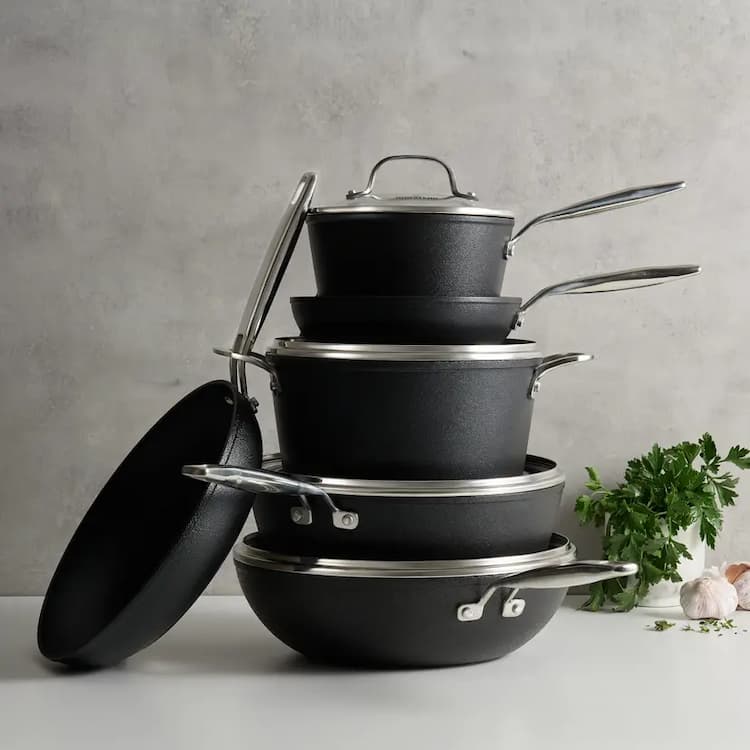Modern technology revolutionises our daily lives and has become a part of our kitchens, too. One of the fastest-growing trends is induction cooking, and for a good reason. Rather than generating heat, induction cooktops produce a magnetic field right above their glass surface, turning the cookware into the source of heat.
Induction cooktops are flat, and they heat food quickly and evenly, but these are not their only advantages. They rarely get hot enough for food to burn onto them, so cleaning is quick and easy. Moreover, induction cooking is more energy efficient than other cooking methods and can help you save time, energy, and money while reducing your carbon footprint.
When it comes to compatibility, not all cookware is created equal. To elevate your time in the kitchen, you can browse induction cookware and find the perfect match for your cooking needs and style. Simply put, it’s any cookware that’s magnetic, and while some can be naturally suitable for induction, others are made suitable for induction. There are many different options to choose from, and here are a few tips to help you narrow down our selection.
A Simple Buying Guide

source: kitchenwarehouse.com.au
Material
Most induction-compatible cookware is made of cast iron or carbon steel, stainless steel, or hard-anodised aluminium. Cast iron and carbon steel are durable, and they hold heat very well. On induction cooktops, cast iron distributes heat evenly, even at low settings.
Stainless steel cookware is sturdy and resistant to rust and corrosion, while hard-anodised aluminium cookware is durable and has an oxidised top layer that prevents scratches and scrapes. Some ceramic-clad and enamelled pots can work with induction cooktops as well. When choosing your induction cookware, look for pans and pots with flat surfaces to ensure complete contact with the stove. To stay on the safe side, always look for the induction-compatible symbol on the cookware.
Different Types Available
Frying Pans
Induction frying pans offer efficient heat distribution and retention and are essential for searing, frying, and sautéing. If you’re new to the induction cooking method, make sure you add at least one to your kitchen arsenal.
Saucepans
Induction saucepans feature tall sides and a tight-fitting lid and are perfect for making sauces, soups, and stews. Their design ensures quick and even heating, and the handle provides a comfortable grip.
Woks
The woks feature a rounded bottom and sloping sides for easy tossing and flipping and a sturdy handle for a secure grip. They’re ideal for stir-frying, steaming, and deep-frying. When it comes to induction cooking, a compatible wok can make a big difference in the overall experience.
Grill Pans
Induction grill pans are designed with a ridged surface and are an excellent choice for grilling meats and veggies. When cooking meat, they create classic grill marks while allowing the excess fat to drain away.
Sauté Pans
Induction sauté pans come with a wide, flat base and high sides. They’re versatile and perfect for sautéing meats, veggies, and more. Their design allows for even browning and caramelisation.
Stockpots
When you need to prepare large batches of soup, chilli, or stock, a stockpot is the right choice. Induction stockpots are durable, and their heat-resistant handles make them easy to use and clean.
Cooking Preferences and Needs
Choosing the right induction burner cookware is not based only on compatibility. Consider your cooking needs and preferences as well, to ensure a more efficient and enjoyable time in the kitchen. If quick and even heating is your priority in the cooking process, choose cast-iron and stainless steel cookware. If you care about aesthetics, ceramic-clad pots are an excellent option.
Size, Weight, and Handle Comfort
Pay attention to details such as the cookware’s size, weight, and handles, all of which can help you create a seamless cooking experience that aligns with your cooking style.
A Few Care Tips
Proper care is essential to ensure the longevity and performance of your cookware. Cookware for induction tops requires similar cleaning methods to non-induction cookware; however, there are a few key cleaning practices to follow. Begin by handwashing instead of using a dishwasher to prevent damage to your pots’ and pans’ surfaces. Don’t use any abrasive scrubbers, and dry them thoroughly after each washing to prevent water spots.
A Few Cooking Tips

source: kitchenwarehouse.com.au
If you’re new to induction cooking, keep in mind that when preparing the first few meals, you’ll need to pay more attention until you adapt to the speed of this cooking method. Take it slow, pay attention, and enjoy the process.
If you’re used to chopping up veggies while the pan gets warm, remember that induction cooking takes less time, so it might be a better idea to adjust your cooking rhythm and prepare some food beforehand.
Final Thoughts
Induction cooking has many benefits, especially for a busy kitchen. Induction cooktops are easy to clean, they’re more energy efficient, and they can simplify cooking, giving you extra time with family. The heating element is never exposed, making induction cooking one of the safest options, especially when cooking with kids or around pets.

